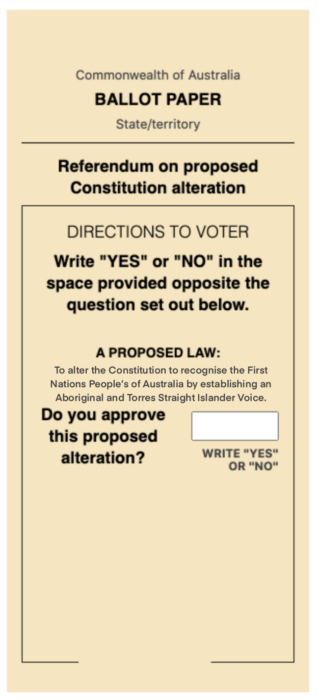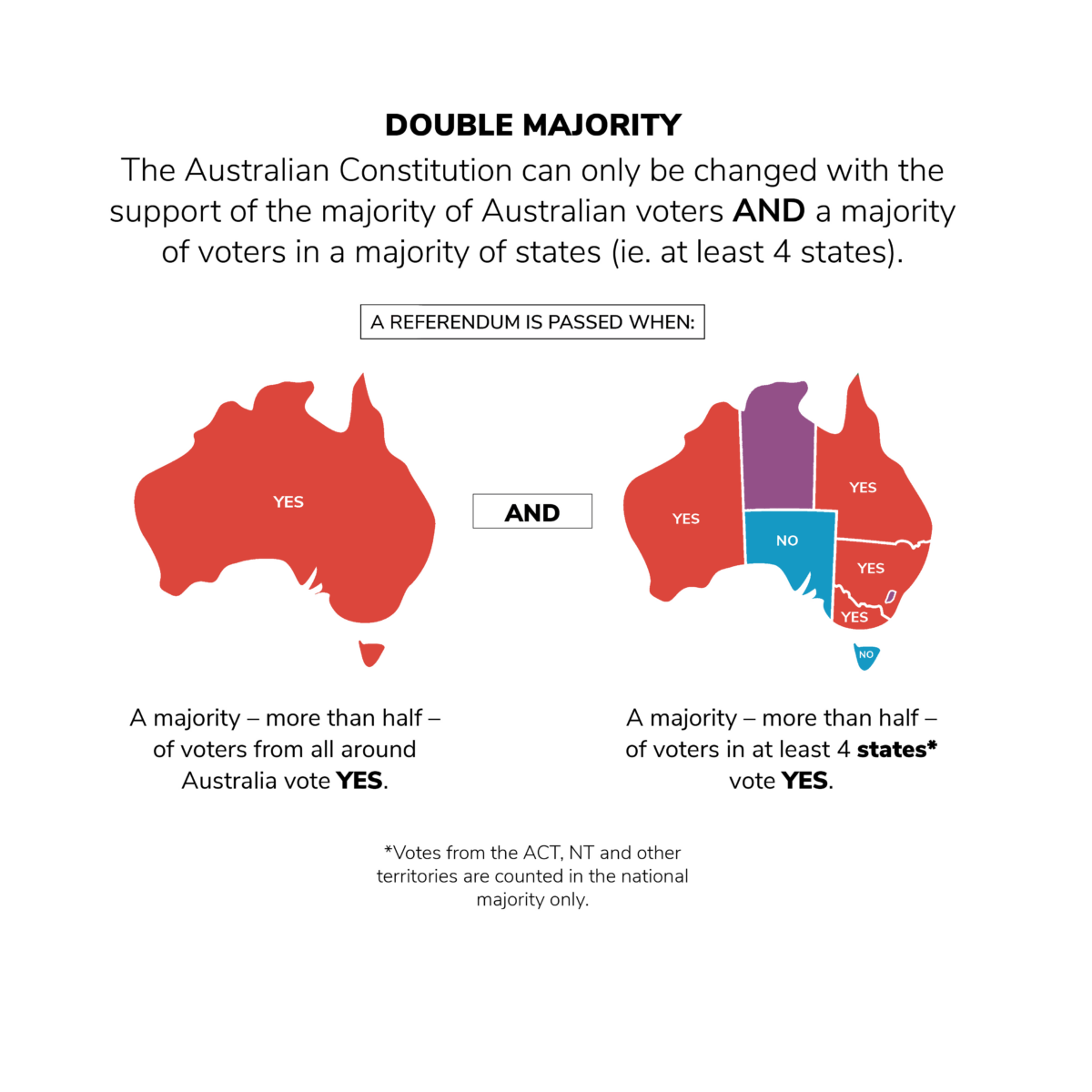Between October and December this year, the Australian people will vote on whether Aboriginal and Torres Strait Islander people should be recognised in the Australian Constitution, through an established Aboriginal and Torres Strait Islander Voice to Parliament.
This fact-file helps to explain the referendum process, the Voice itself, and how to vote in the ACT. The Burgmann and Burton and Garran Hall information session on the Voice helped to inform parts of this article.
What is a referendum?
The Australian Electoral Commision (AEC) defines referendums as a national vote on a question about a proposed change to the Australian Constitution.
This year, the question will be:
“A proposed Law: to alter the Constitution to recognise the First Peoples of Australia by establishing an Aboriginal and Torres Strait Islander Voice. Do you approve this proposed alteration?”
The proposed change to the Constitution is:
“Chapter IX Recognition of Aboriginal and Torres Strait Islander Peoples
129 Aboriginal and Torres Strait Islander Voice
In recognition of Aboriginal and Torres Strait Islander peoples as the First Peoples of Australia:
1: There shall be a body, to be called the Aboriginal and Torres Strait Islander Voice;
2: The Aboriginal and Torres Strait Islander Voice may make representations to the Parliament and the Executive Government of the Commonwealth on matters relating to Aboriginal and Torres Strait Islander peoples;
3: The Parliament shall, subject to this Constitution, have power to make laws with respect to matters relating to the Aboriginal and Torres Strait Islander Voice, including its composition, functions, powers and procedures.”
The Voice:
The Voice will be an independent, representative advisory body for First Nations peoples. It would advise Parliament and the executive government (ministers, departments and public servants) on matters relating to the economic, spiritual and social wellbeing of Aboriginal and Torres Strait Islander people when such matters are relevant to proposed legislation.
If constitutionally enshrined, the Voice will have the following outlook, according to the Australian Government: Aboriginal and Torres Strait Islander Voice.
In terms of composition,
- Members of the Voice will be Aboriginal and Torres Strait Islanders according to the three part test.
- Members will be chosen by the members of Indigenous and Torres Strait Islander communities.
- Mechanisms to choose members will be determined post-referendum and will reflect the wishes of Indigenous and Torres Strait Islander communities.
- Members will be chosen from each state, territory and Torres Strait Islands. It will include specific representatives for remote locations and representatives for the mainland Torres Strait Islander population.
- Members will serve on the Voice for a fixed period of time.
- The Voice will have balanced gender representations and will include younger members.
In terms of responsibilities and powers,
- Members of the Voice are expected to connect with, and represent the wishes of their communities.
- The Voice will consult grassroots communities and regional entities to ensure its representations are informed by lived and historically excluded experiences.
- The Voice will respect the work of existing organisations.
- The Voice will advise the Government and Parliament on matters relating to the social, spiritual and economic wellbeing of Aboriginal and Torres Strait Islander People.
- Parliament will be obliged to consult it on matters that overwhelmingly relate to Indigenous and Torres Strait Islander people. These matters include, but are not limited to Native Title, housing, employment, community development, environment, heritage protection.
- The Voice can respond to requests of representation or advice from the executive government or Parliament.
- The Voice will have its own resources to conduct research, and develop representations.
- The Voice will be able to table formal advice in Parliament. This means the tabled advice will be presented to the chambers of Parliament in the course of its legislative proceedings. A parliamentary committee would consider the advice.
In terms of accountability and transparency,
- Members will fall within the scope of the National Anti-Corruption Commission (NACC). Public officials such as members of Parliament, staff, employees and contractors of Commonwealth agencies and Commonwealth companies also fall under the NACC.
- Members will be sanctioned or removed for serious misconduct.
- The Voice will be subject to standard governance and reporting requirements.
In terms of restrictions:
- The Voice will not be able to propose legislation on the floor of Parliament, nor will it vote on legislation on the floor of Parliament. It can advise the government to propose certain legislations, however the government is not obliged to follow the advice.
- The Voice does not have veto power over legislation.
- The Voice does not confer special rights to Indigenous and Torres Strait Islander people, or any individual. This means that the Voice cannot enshrine exclusive rights on Indigenous and Torre Strait Islander people.
- The Voice will not deliver government programs.
Who is voting in the referendum?
Just like compulsory voting in Australian federal elections, all Australian citizens aged 18 and above registered on the electoral roll must vote in the referendum. Australian citizens who have recently turned 18 years old or have been granted Australian citizenship must enroll to vote. Citizens who are enrolled for elections are already enrolled for referendums. However, if the name or address of a citizen has changed, these details must be updated.
Where to Vote?
Polling day will be on a Saturday, with booths opening at 8am until 6pm.
Early voting centres will be open in the two weeks leading up to voting day for voters who are unable to attend the booth on the pollying day due to illness, injury, travel or safety reasons.
Postal voting will be open to individuals who cannot be available for in-person voting during the early voting period, or the official polling day. These may be individuals who are working, hospitalised or due in a hospital during the period, in prison, a silent voter, a person restricted by their religious beliefs, or those with mobility or disability restriction.
If you are considering applying for postal voting, refer to the AEC website in the months leading up to the referendum. The AEC is yet to publish relevant information on postal voting for the referendum.
If you are overseas when the polling booths for the referendum open, you may consider two of the following:
- Voting in early voting centres, which will be available in the two weeks leading up to voting day.
- Depending on the conditions at the time of the referendum, the Australian Electoral Commission plans to offer voting centres abroad, however this has not been confirmed, nor have overseas voting locations been announced.
What will the ballot paper look like?
Like this:

On the ballot paper, the answer should be indicated clearly in writing;
- YES in the box if the voter approves the proposed change.
- NO in the box if the voter does not approve the proposed change.
For the ballot paper to be properly counted, the individuals are requested to capitalise their answer and write legibly.
Signs such as ticks and crosses will result in an uncounted vote.
Synonyms such as “approved” may be counted, however, “disapproved” and “not approved” will not be counted. However, it is suggested to not use synonyms, rather use YES or NO in the answer box.
Words such as “maybe”, “unsure” or phrases such as “I don’t know” will not be counted. If you are struggling, please ask an electoral officer at the booth for assistance.
The AEC website has a helpful page to practise completing a referendum ballot paper.
How many votes are required to change the constitution?
A referendum passes with a double majority. There are two conditions for a double majority:
- A majority of Australian voters nationwide must vote “YES”.
- A majority of voters in at least four of the six Australian states, must vote “Yes”.
Failure to meet either condition will result in an unchanged constitution. For example, if a majority of Australian voters nationwide vote Yes, but a majority of voters from only three of the six Australian states vote “Yes”–the referendum will not pass. Similarly, if a majority of voters in four or more states vote “Yes”, but a majority of voters nationwide do not vote “Yes”–the referendum will not pass.
Australian voters from the Australian Capital Territory and the Northern Territory participate in referendum voting, however their votes are only counted in the nationwide count.
Note that in referendums voters do not vote twice. Formal votes cast by Australian voters are counted in the national votes, with the same formal votes counted again to determine if the state itself produced a majority of “Yes” or “No” votes.

How do I find out more about this?
The AEC is required to deliver a pamphlet including a passage of argument for and against the proposed change at least 14 days before the polling date to households with one or more enrolled electors. These written passages will be authorised by parliamentary members who voted for or against the proposed change.
The incumbent Labour government has promised a civics and awareness campaign that will educate the public on the facts of the referendum before the polling date. As of now, the Labour government has approved $9.5 million for the campaign.
The 2023 referendum will be the first to disclose the regulation of political finance in reference to referendum spending.
At the ANU, the Indigenous Department has commenced a series of events which provide students an opportunity to hear from and interact with Indigenous members of the community, in regards to the referendum.
Additionally, the ANU has provided FAQs for the referendum, accessed here: Indigenous Voice to Parliament. Note that the ANU has supported the proposed change.
To understand more about the Voice to parliament please visit the following websites:
We acknowledge the Ngunnawal and Ngambri people, who are the Traditional Custodians of the land on which Woroni, Woroni Radio and Woroni TV are created, edited, published, printed and distributed. We pay our respects to Elders past and present. We acknowledge that the name Woroni was taken from the Wadi Wadi Nation without permission, and we are striving to do better for future reconciliation.
